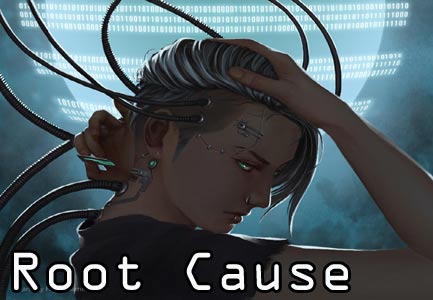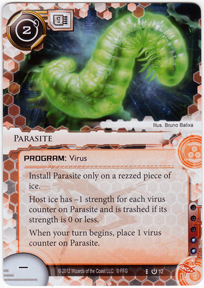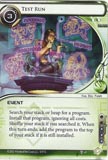Welcome to Card Game DB
Register now to gain access to all of our features. Once registered and logged in, you will be able to create topics, post replies to existing threads, give reputation to your fellow members, get your own private messenger, post status updates, manage your profile and so much more. If you already have an account, login here - otherwise create an account for free today!
Register now to gain access to all of our features. Once registered and logged in, you will be able to create topics, post replies to existing threads, give reputation to your fellow members, get your own private messenger, post status updates, manage your profile and so much more. If you already have an account, login here - otherwise create an account for free today!
Root Cause - Parasite
Apr 29 2013 05:25 PM |
Hraklea
in Android: Netrunner
Android: Netrunner Root Cause Hraklea Anarch Root Cause is a series of bi-weekly Android: Netrunner articles about deck building, strategy and tactical decisions, for new and mid-level Anarch players. It was named in honor of Samantha Groves, the character from the CBS' Person of Interest show played by Amy Acker.
Root Cause is a series of bi-weekly Android: Netrunner articles about deck building, strategy and tactical decisions, for new and mid-level Anarch players. It was named in honor of Samantha Groves, the character from the CBS' Person of Interest show played by Amy Acker.If I had to give one reason to play Anarch, I probably would say Parasite (Core), arguably one of the best runner cards in the core set. Yes, it is cheap to play as an out-of-faction card; yes, high-level players often do that; but, as anarchs, we have more than that... we have Deja Vu (Core): we can play up to 9 copies of it in the same match (and maybe more when Creation and Control comes out!).
Still, until we find a way to play ~20 copies of Parasite, we still have to decide what to trash and what to break, and that might be complicated sometimes. A misjudged decision paired with bad draw is all you need to lose a game. It's common to see new players installing it on the wrong piece of ice by impulse: you draw it, it is good, you play it. This happens because you've not understood the time structure of the game yet.
Android: Netrunner matches have three phases:
1st) the early-game phase, when the corporation doesn't have enough pieces of ice to keep all its servers safe;
2nd) the mid-game phase, when the corporation has pieces of ice to protect all its servers, and the runner doesn't have all the program cards needed to break them;
3rd) and the late-game phase, when the runner has all the programs required to break any ice subroutine required to access the corporation's servers.
While the corporations will try to keep you in the mid-game until they win, Parasite should be pushing the game to your strongest phase. That can be either the early-game (most Criminal decks, for example) or the late-game (most Shaper decks, for example), and some players design their decks to be versatile, doing well on both phases, but not shining in any of them. Whatever the case for your deck, you must have this time structure in mind when picking targets to trash.
Thinking Ahead.
To know what to trash is to know what to break, and to know what to break is to know what not to break. When building your deck, including Parasite implies that you don't need those strong icebreaker program cards that break everything, you only need to break what you'll not trash. That's why Force of Nature (A Study In Static) doesn't get as much love as Yog.0 (Core), for instance.
I keep this list of all pieces of ice in the game to sort the ice subroutines I can break, the ones that require an Ice Carver or 1 virus counter on Datasucker to be broken, and the ones that I can't break. An index like that not only helps you to know your main targets for installing Parasite, it also can tell you how much you actually need of Ice Carver and/or Datasucker, how many copies of Parasite and/or Déjà Vu you should be using, and it even might lead you to rethink your icebreaker program card choices.
Always have a plan B.
Imp (What Lies Ahead) has potential to trash 2 pieces of ice, but accessing them from the R&D server and the HQ server requires some luck. You can't wait for it forever (as the corporation can purge your virus counters), so don't worry too much about using it on the "right" target. Any piece of ice that you can trash is an advantage to you. Also, during the early-game, trashing cards that provide credits to the corporation can make the early-game phase last for a few extra turns, so don't waste an opportunity to trash a Hedge Fund or a PAD Campaign.
Déjà Vu can recycle both Imp and Parasite, and making the right choice might be tricky sometimes. As a general rule, Parasite is a better call, because you always know exactly where you're hosting it. But, if your rig doesn't have enough virus counters, taking 1 copy of Imp back might be a good idea in the early-game. You also might want to save your copies of Déjà Vu to save non-virus cards from trash or damage.
Know your Enemy.
Paying attention to how your opponent has spent his/her influence points will give an important clue about what to expect. Luckily for us, counting cards in Netrunner is pretty easy, as you can have access to the opponent's archives server whenever you want (at least, the face-up cards), and running the central servers is never a bad idea. But remember: it is just a clue.
Players often make the mistake of assuming that no one would do what they would not do, but you have to ready for surprises, especially now that the regionals are happening and you'll play against people you never have seen before, with ideas completely different from yours. I already got hit by a Janus 1.0 (What Lies Ahead) against a Jinteki player, for instance. In most players' opinion, Jinteki's economy does not allow you to use the most expensive piece of ice in the game, but "overestimating" my opponent cost me 3 brain damage - and there wasn't anything to save me, just because I played assuming my opponent would never do something that I considered a bad idea.
Stronger Together
Another important part of playing cards correctly is to know how to explore their synergies. The most common Parasite trick is to use Datasucker counters to make it faster (some people do that with Wyrm (Core)). Ice Carver (Core) can do that too, but it is slower and more expensive, although it doesn't cost any memory, which is important for players that don't have much memory. These in-faction combos are particularly good when you have Test Run (Cyber Exodus), as you can instantly destroy the piece of ice you need to trash. (and you would be able to play up to 12 copies of Parasite!).
Another popular combo is to use Forged Activation Orders (Core) when you know there’s a dangerous piece of ice there, so you don't have to dive into it in order to make the corporation rezz it. You can also use it with Vamp (Trace Amount), if you don't have or don't want to spend your Parasite.
This is just the beginning.
I decided to write about Parasite because it is one of the most used Anarch cards, but you should be going through this process for every card in your deck. Does it fit my strategy? Does it work during the game phase I want the match to be in? How does it interact with my other cards? What's the opportunity cost for including it in my deck? What's the opportunity cost for removing it from my deck? How does it affect my economy? When should I play this card? When should not I play this card? ...I can keep going on forever. You must try to answer as many questions like these as you can, though I doubt you'll ever be able to answer them all.
It’s safe to assume that good players are good because they know the game, and this logic leads us to the conclusion that, if you can't answer all the questions, you are not a good player. It does make sense. The catch here is that good players have not only knowledge, they also have intuition. That’s why reading websites will never be enough.
I'm not talking about that feeling you have when your twin brother/sister or your son gets hurt. By intuition, I mean the things you don't know that you know. A tournament report will detail what the writer considered the most important, but what about those things that he/she doesn’t even remember, because he/she made them on “autopilot� They won’t be there. Do you think high-level players can explain all the card choices in their decks? They try, at best, but often they cannot do it.
So, my tips for this week are: first, as people have different point of views, and the odds are that a good player out there wrote an article explaining the things that another good player couldn’t explain on his/her article, try to read/listen (and discuss) as much as can; second - and more important –, take your time to develop your own intuition. If you’re thinking that the regionals are not worth it, that it’s a waste of money to go on to championships you can’t win, remember how much you can learn from these experiences. Believe me, it is more than you think.
João “Hraklea†Almeida is a brazilian amateur card game player. Started with Magic: the Gathering in 1999 and moved to different card games in 2004, including Pokémon TCG, Dragon Ball Z CCG and The Spoils. Currently playing only Android: Netrunner.
- talism, skiesbleed, Lluluien and 5 others like this



 Sign In
Sign In Create Account
Create Account














3 Comments
Lastly, there is no mention of using Personal Workshop here, but personal workshop with parasites/ice and datasuckers is a huge combo for any killer noise deck.
Your experience on running into Janus 1.0 in a Jinteki deck is great. I think most people would consider running that in Jinteki a bad play, like you say, which is what makes it a good play. If you can pull it off and catch the runner by surprise, Janus can win the game on its own. The flexibility in deck building and room for creativity in Netrunner is what draws me to the game.